 Investment is essential for the growth of any economy, but none more so for an economy recovering from a severe downturn, such as the UK. Not only will it bring in much needed money and then create jobs for UK residents, but it will also continue to build ties between the UK and the world’s fastest growing economy.
Investment is essential for the growth of any economy, but none more so for an economy recovering from a severe downturn, such as the UK. Not only will it bring in much needed money and then create jobs for UK residents, but it will also continue to build ties between the UK and the world’s fastest growing economy.
George Osborne has been in China promoting business opportunities for investment in the UK and one such investment is into Manchester Airport. The ‘Airport City’ Project will be a combined effort, or a Joint Venture, between the Greater Manchester Pension Fund, the UK’s Carillion Plc and Beijing Construction Engineering Group. The plan is to create offices, hotels, warehouses and manufacturing firms, bringing in thousands of jobs in the process, thus providing a much needed boost to the British economy. Britain is already one of the top nations attracting Chinese investment, with more than double the amount of any other European nation. George Osborne is clearly in favour of further improving business ties with China, saying:
I think it shows that our economic plan of doing more business with China and also making sure more economic activity in Britain happens outside the City of London is working…That’s good for Britain and good for British people.
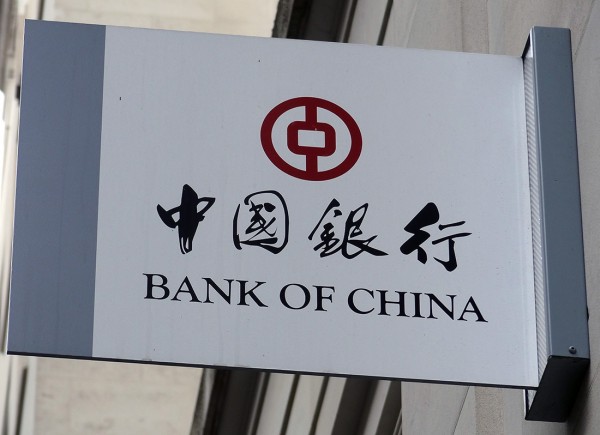 However, the benefit of such investment from China into the UK, is not just of benefit to our domestic economy. China will also reap benefits from its involvement in projects, such as the development of Manchester’s airport. The Managing Director of BCEG, Mr Xing Yan, said:
However, the benefit of such investment from China into the UK, is not just of benefit to our domestic economy. China will also reap benefits from its involvement in projects, such as the development of Manchester’s airport. The Managing Director of BCEG, Mr Xing Yan, said:
To be included in such an interesting and unique development is a real honour…We see our involvement in Airport City as an extension of the memorandum of understanding between China and the UK, where we have been looking to further explore joint infrastructure opportunities for some time.
The airport investment by China is only one of many of its recent forays into the UK economy. Other investments include plans to rebuild London’s Crystal Palace and plans to create a third financial district near London’s City Airport.
Some may see more Chinese involvement in UK business as a threat, but for most it is viewed as an opportunity. An opportunity that both Boris Johnson and George Osborne will undoubtedly exploit as far as possible, with the hope that it will generate income, employment and growth. The following articles consider this investment opportunity.
Manchester Airport Group announces jobs boost The Telegraph, David Millward (13/10/13)
China’s BCEG joins UK Manchester airport joint venture Reuters (13/10/13)
Manchester Airport to receive investment from China BBC News (13/10/13)
George Osborne hails China’s airport investment The Telegraph (13/10/13)
Chinese group in $1.2bn British airport development deal The Economic Times (13/10/13)
China in £800m Manchester airport deal Financial Times, Elizabeth Rigby and Lucy Hornby (13/10/13)
Boris and Osborne in China to push trade Sky News, Mark Stone (13/10/13)
What does China own in Britain? BBC News (14/10/13)
Questions
- What is a joint venture? What are the advantages and disadvantages of a joint venture relative to other business structures?
- How important are political ties with China?
- Do you view Chinese investment in the UK as an opportunity or a threat? Make a list for each side of the argument, ensuring you offer explanations for each reason.
- What macroeconomic benefits will the development of the Manchester Airport bring to the city?
- Will there be wider economic benefits to the rest of the UK, despite the investment being located in Manchester?
- Using the AD/AS model, illustrate and explain why investment is so important to the recovery of the UK economy.
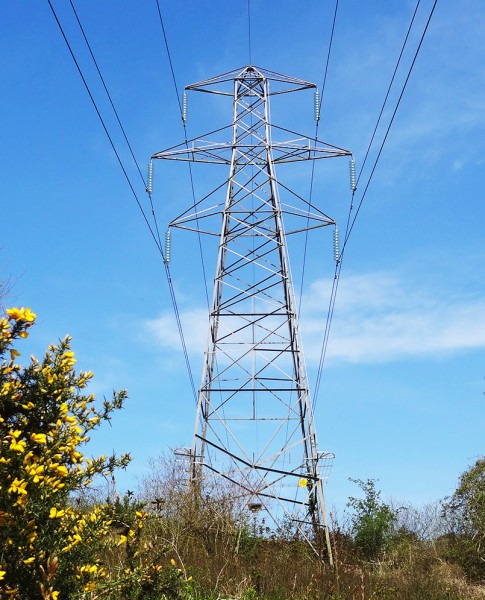 The cost of living is a contentious issue and is likely to form a key part of the political debate for the next few years. This debate has been fuelled by the latest announcement by SSE of an average rise in consumer energy bills of 8.2%, meaning that an average dual-fuel customer would see its bill rise by £106. With this increase, the expectation is that the other big energy companies will follow suit with their own price rises.
The cost of living is a contentious issue and is likely to form a key part of the political debate for the next few years. This debate has been fuelled by the latest announcement by SSE of an average rise in consumer energy bills of 8.2%, meaning that an average dual-fuel customer would see its bill rise by £106. With this increase, the expectation is that the other big energy companies will follow suit with their own price rises.
Energy prices are made up of numerous factors, including wholesale prices, investment in infrastructure and innovation, together with government green energy taxes. SSE has put their price hike down to an increase in wholesale prices, but has also passed part of the blame onto the government by suggesting that the price hikes are required to offset the government’s energy taxes. Will Morris, from SSE said:
We’re sorry we have to do this…We’ve done as much as we could to keep prices down, but the reality is that buying wholesale energy in global markets, delivering it to customers’ homes, and government-imposed levies collected through bills – endorsed by all the major parties – all cost more than they did last year.
The price hike has been met with outrage from customers and the government and has provided Ed Miliband with further ammunition against the Coalition’s policies. However, even this announcement has yet to provide the support for Labour’s plans to freeze energy prices, as discussed in the blog Miliband’s freeze.  Customers with other energy companies are likely to see similar price rises in the coming months, as SSE’s announcement is only the first of many. A key question is how will the country provide the funding for much needed investment in the energy sector? The funds of the government are certainly not going to be available to provide investment, so the job must pass to the energy companies and in turn the consumers. It is this that is given as a key reason for the price rises.
Customers with other energy companies are likely to see similar price rises in the coming months, as SSE’s announcement is only the first of many. A key question is how will the country provide the funding for much needed investment in the energy sector? The funds of the government are certainly not going to be available to provide investment, so the job must pass to the energy companies and in turn the consumers. It is this that is given as a key reason for the price rises.
Investment in the energy infrastructure is essential for the British economy, especially given the lack of investment that we have seen over successive governments – both Labour and Conservative. Furthermore, the government’s green targets are essential and taxation is a key mechanism to meet them. Labour has been criticized for its plans to freeze energy prices, which may jeopardise these targets. The political playing field is always fraught with controversy and it seems that energy prices and thus the cost of living will remain at the centre of it for many months.
 More energy price rises expected after SSE increase BBC News (10/10/13)
More energy price rises expected after SSE increase BBC News (10/10/13)
SSE retail boss blames government for energy price rise The Telegraph, Rebecca Clancy (10/10/13)
A better way to take the heat out of energy prices The Telegraph (11/10/13)
SSE energy price rise stokes political row Financial Times, John Aglionby and Guy Chazan (10/10/13)
Ed Miliband condemns ‘rip-off’ energy firms after SSE 8% price rise The Guardian, Terry Macalister, Angela Monaghan and Rowena Mason (28/9/12)
Coalition parties split over energy companies’ green obligations Independent, Nigel Morris (11/10/13)
Energy price rise: David Cameron defends green subsidies The Guardian, Rowena Mason (10/10/13)
‘Find better deals’ users urged as energy bills soar Daily Echo (11/10/13)
Energy Minister in row over cost of taxes Sky News (10/10/13)
SSE energy price rise ‘a bitter pill for customers’ The Guardian, Angela Monaghan (10/10/13)
Energy firm hikes prices, fuels political row Associated Press (10/10/13)
Only full-scale reform of our energy market will prevent endless price rises The Observer, Phillip Lee (27/10/13)
Questions
- In what market structure would you place the energy sector?
- Explain how green taxes push up energy bills? Use a diagram to support your answer.
- Consider the energy bill of an average household. Using your knowledge and the articles above, allocate the percentage of that bill that is derived from wholesale prices, green taxes, investment in infrastructure and any other factors. Which are the key factors that have risen, which has forced SSE (and others) to push up prices?
- Why is investment in energy infrastructure and new forms of fuel essential? How might such investment affect future prices?
- Why has Labour’s proposed 20-month price freeze been criticised?
- What has happened to energy prices over the past 20 years?
- Is there now a call for more government regulation in the energy sector to allay fears of rises in the cost of living adversely affecting the poorest households?
 No matter the product or service, price is always a key factor and never more so than in tough economic times. In most cases, prices are allowed to be determined by the forces of demand and supply, which gives the equilibrium price. However, in some cases, the government may choose to intervene with a price control, for example rent controls and the national minimum wage. Another market where there is also regulation is the airline industry and the Civil Aviation Authority have recently been criticized by Heathrow Airport for its price control plan.
No matter the product or service, price is always a key factor and never more so than in tough economic times. In most cases, prices are allowed to be determined by the forces of demand and supply, which gives the equilibrium price. However, in some cases, the government may choose to intervene with a price control, for example rent controls and the national minimum wage. Another market where there is also regulation is the airline industry and the Civil Aviation Authority have recently been criticized by Heathrow Airport for its price control plan.
Whenever we go on holiday, the price we pay for an airline ticket will depend in part on the airport we are taking off from and landing at, as they will charge the airline for landing fees, security, terminals etc.  Heathrow airport had proposed that annual rises to its tariffs charged to airlines would increase by 4.6% above RPI inflation. However, this plan has been rejected by the CAA, which has said that the annual tariff rise between 2014 and 2018 should not be above the RPI. Though Heathrow are criticizing the CAA about this restriction, it is an improvement from the initial proposal which would have capped price rises at the RPI minus 1.3%.
Heathrow airport had proposed that annual rises to its tariffs charged to airlines would increase by 4.6% above RPI inflation. However, this plan has been rejected by the CAA, which has said that the annual tariff rise between 2014 and 2018 should not be above the RPI. Though Heathrow are criticizing the CAA about this restriction, it is an improvement from the initial proposal which would have capped price rises at the RPI minus 1.3%.
Controversy has naturally been created, with the CAA arguing that such price controls are needed to keep prices down and thus benefit consumers and retain the competitiveness of Heathrow airport. But, in contrast, Heathrow has argued that such a cap will put its competitive position under pressure and will risk future investment in the UK. But this isn’t the only criticism of the CAA. Airlines aren’t happy with the ruling either, arguing that the CAA has bowed to the pressure of Heathrow. The contrasting positions of the CAA, Heathrow and airlines are evident in the following quotes, firstly from the Chairwoman of the CAA:
The proposals will put an end to over a decade of prices rising faster than inflation at Heathrow. Tackling the upward drift in Heathrow’s prices is essential to safeguard its globally competitive position. The challenge for Heathrow is to maintain high levels of customer service while reducing costs. We are confident this is possible and that our proposals create a positive climate for further capital investment, in the passenger interest.
Secondly, from Heathrow’s Chief Executive:
This proposal is the toughest Heathrow has ever faced. The CAA’s settlement could have serious and far-reaching consequences for passengers and airlines at Heathrow … We want to continue to improve Heathrow for passengers. Instead, the CAA’s proposals risk not only Heathrow’s competitive position but the attractiveness of the UK as a centre for international investment. We will now carefully consider our investment plans before responding fully to the CAA.
And finally from the IAG Chief Executive, who said:
[The CAA] neglected its new primary statutory duty to further the interests of passengers by endorsing a settlement that allows the UK’s monopoly hub to ignore its inefficiencies and over-reward investors by imposing excessive charges … It is a bad day for customers who have been let down by the CAA.
Any price rise from the airports will be passed on to airlines and these in turn will translate into higher prices for customers. However, is there any truth to Heathrow’s claims that investment will be adversely impacted? As costs rise, profit margins and profit will fall, unless the revenue generated can increase. Price controls restrict the amount that prices can rise and thus unless demand increases by a significant margin, profits will decline. With lower profits, there will be less money for investment and arguably the service that customers face will also decline. However, the CAA suggests that Heathrow will be able to cut its costs and thus protect investment into the future, while retaining its competitive position globally by charging lower prices to airlines. This is unlikely to be the end of the journey, but for the moment, the CAA appears to have put its foot down. The following articles consider the battleground between the CAA and Heathrow.
Regulation in the passenger’s interest, support investment and driving competition The Civil Aviation Authority (3/10/13)
Passengers at Heathrow ‘face £1bn fares hike’ Independent, Matthew Beard (4/10/13)
 Heathrow airport attacks regulator’s price control plan BBC News (3/10/13)
Heathrow airport attacks regulator’s price control plan BBC News (3/10/13)
CAA proposed Heathrow charges rise in line with inflation The Telegraph, Rebecca Clancy (13/10/13)
Passengers face fare increases as Heathrow and Gatwick are allowed to up landing fees Mail Online (3/10/13)
Heathrow and airlines enraged by CAA price proposals The Telegraph, Alistair Osborne (3/10/13)
Heathrow attacks Civil Aviation Authority over airport charges Financial Times, Andrew Parker (3/10/13)
BAA considers life outside Heathrow as CAA backtracks on charges The Guardian, Gwyn Topham (3/10/13)
Heathrow charge plan disappoints all round Wall Street Journal, Peter Evans (3/10/13)
Questions
- What is the role of a regulator?
- Explain how the price control outlined by the CAA will affect Heathrow.
- If Heathrow is unable to cut costs, what is the likely effect? Using a diagram illustrate the impact on profitability if costs (a) can be reduced and (b) cannot be reduced.
- Why are the CAA being criticised by airlines and airports?
- How will customers be affected by Heathrow’s planned price rises and the CAA’s proposal?
- ‘Regulation in the airlines industry is essential to retain competitiveness.’ Evaluate the validity of this statement.
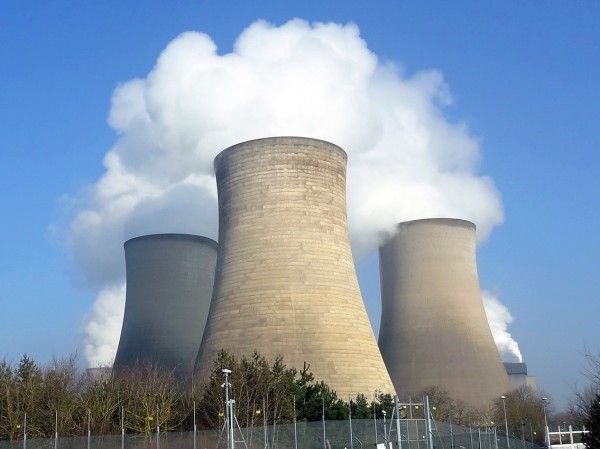 For all households, energy is considered an essential item. As electricity and gas prices rise and fall, many of us don’t think twice about turning on the lights, cooking a meal or turning on the heating. We may complain about the cost and want prices brought down, but we still pay the bills. But, is there anything that can be done about high energy prices? And if there is, should anything be done?
For all households, energy is considered an essential item. As electricity and gas prices rise and fall, many of us don’t think twice about turning on the lights, cooking a meal or turning on the heating. We may complain about the cost and want prices brought down, but we still pay the bills. But, is there anything that can be done about high energy prices? And if there is, should anything be done?
The worlds of politics and economics are closely linked and Ed Miliband’s announcement of his party’s plans to impose a 20-month freeze on energy prices if elected in 2015 showed this relationship to be as strong as ever. The price freeze would certainly help average households reduce their cost of living by around £120 and estimates suggest businesses would save £1800 over this 20 month period. The energy companies have come in for a lot of criticism, in particular relating to their control of the industry. The sector is dominated by six big companies – your typical oligopoly, and this makes it very difficult for new firms to enter. Thus competition is restricted. But is a price freeze a good policy?
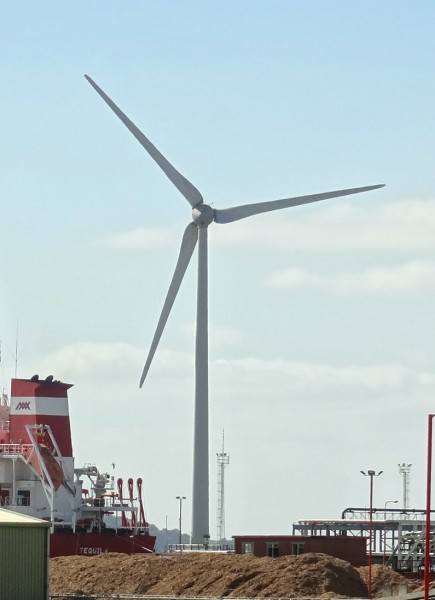 Part of the prices we pay go towards investment in cleaner and more environmentally friendly sources of energy. Critics suggest that any price freeze would deprive the energy sector of much needed investment, meaning our energy bills will be higher in the future. Furthermore, some argue this price freeze suggests that Labour is abandoning its environmental policy. Energy shortages have been a concern, especially with the cold weather the UK experienced a few years ago. This issue may reappear with price freezes. As Angela Knight, from Energy UK, suggests:
Part of the prices we pay go towards investment in cleaner and more environmentally friendly sources of energy. Critics suggest that any price freeze would deprive the energy sector of much needed investment, meaning our energy bills will be higher in the future. Furthermore, some argue this price freeze suggests that Labour is abandoning its environmental policy. Energy shortages have been a concern, especially with the cold weather the UK experienced a few years ago. This issue may reappear with price freezes. As Angela Knight, from Energy UK, suggests:
Freezing the bill may be superficially attractive, but it will also freeze the money to build and renew power stations, freeze the jobs and livelihoods of the 600,000-plus people dependent on the energy industry and make the prospect of energy shortages a reality, pushing up the prices for everyone.
There is a further concern and that is that large energy companies will be driven from the UK. This thought was echoed by many companies, in particular the British Gas owner Centrica, commenting that:
If prices were to be controlled against a background of rising costs it would simply not be economically viable for Centrica to continue to operate and far less to meet the sizeable investment challenge that the industry is facing…The impact of such a policy would be damaging for the country’s long-term prosperity and for our customers.
Share prices naturally fluctuate with global events and a political announcement such as this was inevitably going to cause an effect. But, perhaps the effect was not expected to be as big as the one we saw. 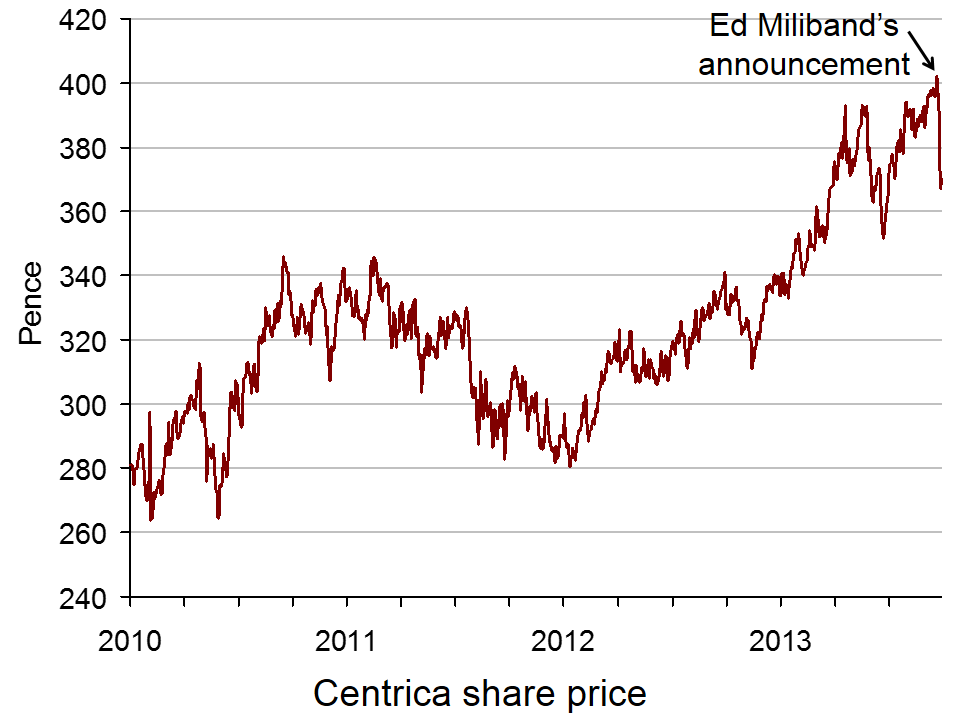 Share prices for Centrica and SSE fell following the announcement – perhaps no great shock – but then they continued to fall. The market value tumbled by 5% and share prices kept falling. This has led to Ed Miliband being accused of ‘economic vandalism’ by a major shareholder of Centrica, which is hardly surprising, given the estimated cost of such a price freeze would be £4.5 billion.
Share prices for Centrica and SSE fell following the announcement – perhaps no great shock – but then they continued to fall. The market value tumbled by 5% and share prices kept falling. This has led to Ed Miliband being accused of ‘economic vandalism’ by a major shareholder of Centrica, which is hardly surprising, given the estimated cost of such a price freeze would be £4.5 billion.
The economic implications of such a move are significant. The announcement itself has caused massive changes in the FTSE and if such a move were to go ahead if Labour were elected in 2015, there would be serious consequences. While families would benefit, at least in the short term, there would inevitably be serious implications for businesses, the environmental policy of the government, especially relating to investment and the overall state of the economy. The following articles consider the aftermath of Ed Miliband’s announcement.
Miliband stands firm in battle over fuel bills plan The Guardian, Patrick Wintour and Terry Macalister (25/9/13)
Michael Fallon calls Miliband’s energy prices pledge ‘dangerous’ Financial Times, Elizabeth Rigby and Jim Pickard (26/9/13)
Britain’s labour treads narrow path between populism and prudence Reuters (26/9/12)
Ed Miliband’s radical reforms will make the energy market work for the many Independent (26/9/13)
Has Labour fallen out of love with Business? BBC News (26/9/13)
Top Centrica shareholder Neil Woodford accuses Labour leader Ed Miliband of economic vandalism The Telegraph, Kamal Ahmed (25/9/13)
Centrica and SSE slide after Labour price freeze pledge The Guardian (26/9/13)
Ed Miliband’s energy price freeze pledge is a timely but risky move The Guardian, Rowena Mason (24/9/13)
Questions
- Why are energy prices such a controversial topic?
- How are energy prices currently determined? Use a diagram to illustrate your answer. By adapting this diagram, illustrate the effect of a price control being imposed. How could it create an energy shortage? What impact would this have after the 20-month price freeze
- Why would there be adverse effects on energy companies if prices were frozen and costs increased? Use a diagram to illustrate the problem and use your answer to explain why energy companies might leave the UK.
- How would frozen energy prices help households and businesses?
- Why were share prices in Centrica and SSE adversely affected?
- Is there an argument for regulating other markets with price controls?
- Why is there such little competition in the energy sector?
 The 2020 Olympics has just been awarded to Tokyo, beating Madrid and Istanbul. Concerns over the safety of the games in Tokyo, with the city being perceived as relatively close to the Fukushima nuclear plant, were overcome with the help of an address by the Japanese Prime Minister, Shinzo Abe. So, what are the economic implications of this latest development in the sporting world?
The 2020 Olympics has just been awarded to Tokyo, beating Madrid and Istanbul. Concerns over the safety of the games in Tokyo, with the city being perceived as relatively close to the Fukushima nuclear plant, were overcome with the help of an address by the Japanese Prime Minister, Shinzo Abe. So, what are the economic implications of this latest development in the sporting world?
When London was awarded the 2012 Olympic Games, estimates suggested that it would generate a £16.5 billion contribution to GDP. With many new construction projects, there was the inevitable injection of government expenditure. This led to the creation of new jobs and thus successive employment multiplier effects were generated. This is also likely to be true for Tokyo, with current proposals suggesting that ten new permanent sites will be built to host the various sports of the Games. This will undoubtedly generate new jobs and will provide an almost certain boost to the construction industry. This, in turn, will generate further multiplier effects across a multitude of industries and across the rest of the country.
 There will also be further economic effects, for example on Japanese investment and stocks and shares, with a boost in confidence and optimism. A Tokyo-based fund manager, Hiroshi Fujumonto, said:
There will also be further economic effects, for example on Japanese investment and stocks and shares, with a boost in confidence and optimism. A Tokyo-based fund manager, Hiroshi Fujumonto, said:
Olympics-related stocks are yet to fully price in the decision, even though they’ve already outperformed … In the short term the entire Japanese share market will get a boost from celebratory buying and expectations for the event’s economic impact.
This was also confirmed by Shinzo Abe, when he commented after the victory was announced that ‘I want to make the Olympics a trigger for sweeping away 15 years of deflation economic shrinkage.’  The Japanese economy has been struggling for many years and this may be the much needed boost to the country’s optimism, infrastructure and economy.
The Japanese economy has been struggling for many years and this may be the much needed boost to the country’s optimism, infrastructure and economy.
As the world’s third largest economy, this economic boost is also likely to have knock-on effects on other countries across the world, though it is more likely to be the long-term impact that is important here. Just as it was with the London Olympics, the final effect and cost will only be known some years after the Olympics are held, but for now the work will start for Japan.
Olympics 2020: Tokyo wins race to host games BBC Sport (7/9/13)
Tokyo Olympics win seen boosting infrastructure, recovery Bloomberg, Yoshiaki Nohara and Satoshi Kawano (8/9/13)
Tokyo wins bid to host 2020 Olympic Games Telegraph, Ben Rumsby (8/9/13)
Tokyo chosen as ‘safe pair of hands’ to host 2020 Olympics Financial Times, Benedict Mander (8/9/13)
Japanese bid’s passion earns Tokyo the 2020 Olympic Games Guardian, Owen Gibson (7/9/13)
Olympics 2020: Why Tokyo is a ‘safe pair of hands’ to host Games BBC News, David Bond (8/9/13)
Questions
- What is the multiplier effect and how is it calculated?
- How can the overall economic benefits of the Olympic Games be estimated?
- Which industries in Tokyo are likely to be the ones that benefit from the Olympic Games?
- Outline a cost–benefit analysis of the Olympic Games.
- Why are share prices likely to go up in Japan based on this news? Look at both the demand and supply factors that will affect share prices.
- Is it possible that there will be wider multiplier effects on other countries besides Japan?
 Investment is essential for the growth of any economy, but none more so for an economy recovering from a severe downturn, such as the UK. Not only will it bring in much needed money and then create jobs for UK residents, but it will also continue to build ties between the UK and the world’s fastest growing economy.
Investment is essential for the growth of any economy, but none more so for an economy recovering from a severe downturn, such as the UK. Not only will it bring in much needed money and then create jobs for UK residents, but it will also continue to build ties between the UK and the world’s fastest growing economy. However, the benefit of such investment from China into the UK, is not just of benefit to our domestic economy. China will also reap benefits from its involvement in projects, such as the development of Manchester’s airport. The Managing Director of BCEG, Mr Xing Yan, said:
However, the benefit of such investment from China into the UK, is not just of benefit to our domestic economy. China will also reap benefits from its involvement in projects, such as the development of Manchester’s airport. The Managing Director of BCEG, Mr Xing Yan, said:









